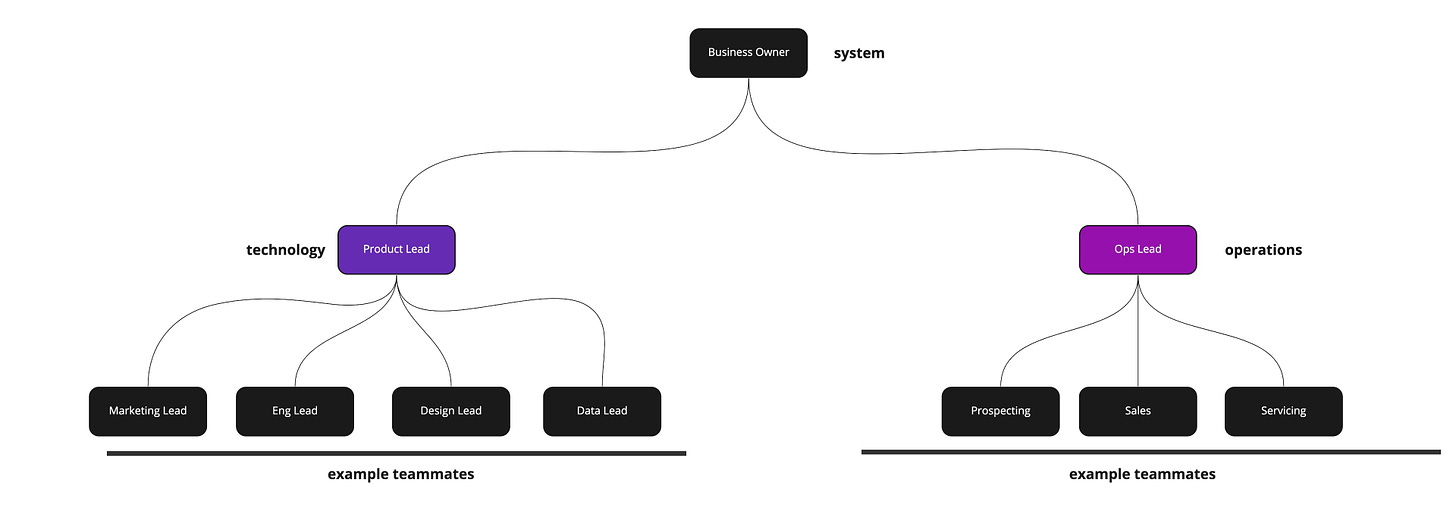Organizational Design: Balancing Technology and Operations
Understanding the Three Essential Roles for Scale
After a startup reaches product-market fit, the founders have a dilemma — they have to manage the current business while simultaneously innovating and building out their product. This can be a hard balancing act for entrepreneurs. Often this situation requires the introduction of operating discipline and the team to subdivide into specialized areas around operations and technology.
What’s often misunderstood is that technology and operations roles have very different operating paradigms, and that as these functional groups scale, it’s also important to maintain a clear business owner who bridges the gap between the two disciplines.
Business systems maps make it easy to split the organization and ensure that the organization is focusing on business outcomes.
Recapping Systems
In Why Leader Should Start and End With a Map, I shared why business systems maps are ideal for organizational design and how they help abstract complexity since they have clear inputs/outputs with feedback loops for self correction.
Additionally, I shared how we used these maps to provide clarity and context and help our leaders think strategically with an example that we used during the early days of Doorstead to get everyone on the same page.
Introducing Three Organizational Roles
Sometimes, as an organization scales, the assumption is that the operations team owns the business, and in other cases, the product team. Without a single-threaded owner, it becomes true that no one owns the business. The eventual outcome of this is an organization that systematically leads to “inattention to results” (see The Five Dysfunctions of a Team).
To avoid this, I’ve found that having an explicit role definition for each of the following three roles is key to success: the operations lead, the product lead, and the business owner. The operations lead is responsible for running the day-to-day operations of the business and making sure that all of the business outcomes are being delivered successfully. The product lead is responsible for monitoring and improving the system efficiency over time. The business owner has end-to-end ownership over the P&L and ensuring that operations and product are working well together.
In a small team, the business owner will often wear the product and/or operations hat. It can be good practice to call this out explicitly since it can help a leader subdivide their teams over time. As the organization scales, many of the specialized roles will shift to a functional organization with a dotted line reporting structure to improve craft.
The Operations Lead
The operations lead is responsible for running the day-to-day operations of the business and delivering service outcomes to the customer. The operations lead typically works in a task management system that enables them to see what needs to get done and when it needs to get done.
The team is focused on business outcomes, such as the # of sales that were completed each day, the number of jobs or activities dispatched, or the support tickets that were resolved. These metrics are primarily tracked on an accounting basis (i.e. when the outcome occurred).
This is an execution-oriented role and often a stressful role since everything needs to be done on time, every time. As such, they’re often held accountable to the only business outcomes that are within their control.
The Product Lead
The product lead is responsible for maintaining and improving the efficiency of each technology system. It is important to call out that before product-market fit, the product management role doesn’t really exist or needs to be tightly coupled with the business owner. After product-market fit, it becomes necessary to scale the product team and the primary mode of operation for the team should be experimentation.
The key tool used to improve the business system is to look at a product cohort and identify opportunities for improvement. This cohort analysis enables the product lead to see whether a system is getting better/worse over time and understand the reasons why.
Most often, the product lead has a comprehensive roadmap that is prioritized by business return-on-investment. This allows everyone to align and understand the cost-benefit analysis for each initiative and why it is important for the business to invest in this area. Without metrics that are tied directly to business results, it can be difficult to integrate product with the operations team and deliver results.
Unlike their operational counterparts who operate in checklists, product leads tend to orient their teams on bi-weekly sprints.
The Business Owner
Finally, the business owner has end-to-end ownership over the P&L and ensuring that everything in the system is flowing well together. This means that they have to balance between running the current business and improving the business. They’re held accountable to the end results of the business and how these are performing relative to plan.
In their toolkit, they should have a business process or systems map that outline all of the key processes and handoffs within their domain. This allows everyone from operations and product to speak the same language and communicate with each other in clear, concrete terms. Without this map, ambiguity often prevails and it often leads to “artificial harmony.”
The business owner will focus on the business inputs (e.g. ad spend), outputs (e.g. closed sales), efficiency (e.g. cost-per-acquisition), and quality (e.g. terminations). They use weekly checkins with their team to make sure everything on track and set up meetings to dive into any variances that are unexpected from plan. This will often involve reconciling the difference between both accounting-based metrics and cohort-based metrics.
Conclusion
In order to manage a growing organization efficiently, it is important to be aware of the three organizational roles for scaling a business. At every level of the organization, there should be one person is directly responsible, and accountable for each of the roles. By cascading the organization around business maps, it makes it easier to ensure that all your teams are operating together to the same goal.








